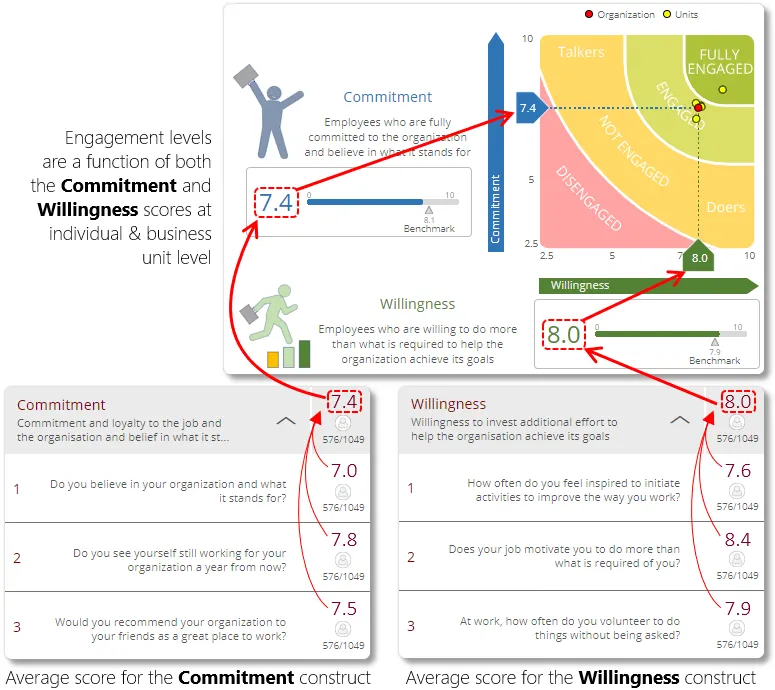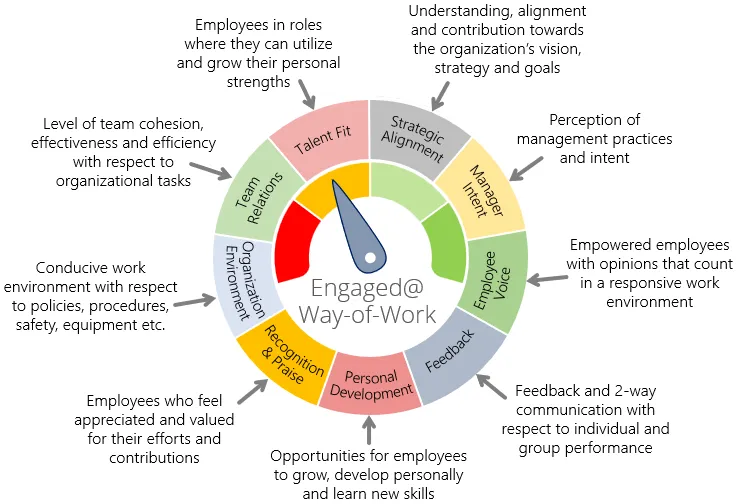Mindset's Flow@Work and the derivative Engaged@Way-of-Work are the only statistically validated engagement surveys that measure not only the engagement levels in your organization (how engaged your employees are), but also the factors that inhibit or drive engagement at business unit and demographic level so you know where to focus and what needs fixing:
- The Indicators of Engagement measure the level of engagement, i.e. the outcomes of engagement, or how engaged an employee or business unit is. The indicators of engagement is like a fuel gauge in a car: the needle shows you how much fuel you have left in the tank, but that is its only purpose – you can’t move the needle by tapping on the gauge with your finger.
- The Drivers of Engagement are the contributing factors that have a direct impact on engagement levels, i.e. the issues that inhibit or drive engagement that you have to identify, diagnose and fix if you want to move the engagement needle and improve the levels of engagement (indicators). To use the fuel gauge analogy again: to move the needle of the fuel gauge, you have to diagnose the reason why the needle shows ‘empty’ – it could be because you have used up all the fuel, or there could be a leak somewhere in the system (fuel tank, fuel pump, engine etc.). To move the engagement needle, you have to diagnose and fix the issues (drivers) that have a direct impact on engagement, e.g. strategic alignment, manager intent, employee voice etc.
Interesting fact: our research shows that there is a close to 80% statistical correlation between the direct manager’s relationship with his/her team and the team’s engagement level.
Measuring the Indicators of Engagement
The Flow@Work engagement model defines engagement as employees who are emotionally committed to the organisation and who are willing to translate this commitment into discretionary effort. The levels of engagement in an organization or business unit are therefore measured with respect to these two indicator dimensions:
Indicator #1: the employees' commitment to the organization, its leadership and it values; and
- Indicator #2: their willingness to go above and beyond what is expected of them (discretionary effort) to help the organisation meets its objectives.
The business unit or team's survey scores for both the Commitment and Willingness indicator dimensions are used in combination as the basis to calculate their engagement levels, and are plotted on a 2-axis graph for maximum visual impact:
- Fully engaged (star performers) – highly committed and loyal employees who add value to the organization and who are prepared to do more than what is required of them (score > ±8.0 for both indicators);
- Engaged (key contributors) – reliable employees who do what is expected of them but are at times inclined to be complacent and risk averse (score > ±6.5 for both indicators);
- Not engaged (passengers) – indifferent and frustrated employees with low levels of energy who resist change and who generally do only the minimum to get by (score > ±5.0 for both indicators); and
- Disengaged (derailers) – dissatisfied and unhappy employees with a negative influence on their colleagues and who are most likely looking for another job (score < ±5.0 for either of the indicators).
Note: users can edit or change the labels (e.g. "derailers") and descriptions (e.g. "dissatisfied employees with a contagious...") that are used to describe the different levels of engagement - see Survey Settings for more.

Understanding the Drivers of Employee Engagement
Mindset’s validated Flow@Work engagement model measures the aspects in the work environment that have a direct impact on the levels of engagement in the organization. We achieve this by grouping employee feedback into 9 scientifically researched dimensions or drivers – covering from strategic-level insights to management practices and talent fit on an individual employee level.

Note: users can edit or change the engagement driver constructs as required, or they can use their own set of engagement drivers by combining Flow@Work's Willingness and Commitment indicator constructs with their own custom engagement surveys - see Indicator Analytics for more on this.
| For more information, click on a sub-menu item at the top of the page⇑ or in the right margin⇒ |
